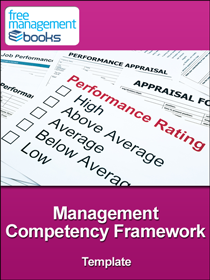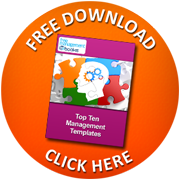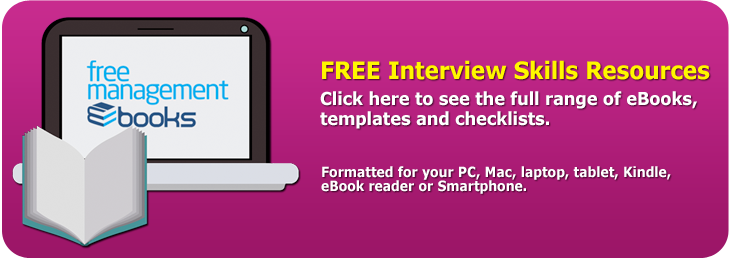Management Competency Framework Template
 |
 |
|
 |
||
The use of a competency framework offers organizations and the individual a consistent and organized way to measure behaviors. It plays an increasingly significant role in recruitment and offers structured support to an individual as part of their continuous professional development. This template enables you to determine two things with regard to the twelve common competencies used in organization's management competency framework. Firstly, do you exhibit each behavior in your work personality? Secondly, is your behavior at the appropriate level for the role you seek?
There are three factors used to measure a behavior these are Knowledge, Skills and Attitudes/Aptitudes (KSA's). The components of each factor are listed below and illustrate how a behavior is assessed in connection with a specific role.
KNOWLEDGE
• How do you use your existing knowledge?
• Does this match the expected behavior of someone performing the role?
• Do you use the same number and variety of information sources as that expected of the role (i.e. principles, facts, ideas etc.)?
SKILL
• What are your abilities?
• Are your learned experiences pertinent to the role?
• Can your level of skill match that required of the role?
• How do you address a variation or deficiency in a required skill?
ATTITUDE / APTITUDE
• Is your attitude towards others you interact with appropriate for the role?
• Do you have the capacity to adapt your behavior to any situation or scenario you could face in the role?
![]()
![]()
The measurement of behaviors is concerned with how you perform a task rather than what you are expected to achieve. It is how you resolve a client issue rather than meeting your objective to always answer a call within three rings. The benefits a management competency framework offers are:
- Consistent measurement of performance. This gives the organization the advantage of being able to easily assessing and monitoring performance of an objective.
- Structured way to define and describe behavior.
- A common language is used throughout an organization when describing behaviors.
- The framework and its definitions provide an excellent foundation on which to base objective and constructive feedback to individuals.
- Makes an excellent self-assessment tool for individuals to identify areas of professional development required.
- Provides a proven mechanism to construct a development plan from so that future aspirations can be met.
By using a competency framework for each role level organizations can ensure productive and effective employees. It also provides a mechanism for developing people to reach their full potential.
The alphabetical list and the definitions below are typical of a management competency framework.
1) Change Agent is defined as:
a) The work environment should be stimulating and enable people to be creative so that new ideas can be generated adding value to the organization.
b) Their flexibility welcomes change and assists in its implementation.
2) Continual Improvement can be defined as:
a) Showing commitment to the maintaining of high standards.
b) Always seeking ways to improve the service offering.
3) Customer Focused is commonly defined as:
a) Understanding and identifying the needs of existing and potential customers.
b) Ensure that the main focus and priority is on meeting customer needs.
4) Decision Making is defined as:
a) The ability to identify and respond creatively to actual and potential problems and opportunities.
b) Decisions made from a structured analytical approach to the collection and examination of data based on organizational needs.
5) Interpersonal Communications is commonly defined as:
a) Builds and maintains good working relationships throughout the Organization and externally.
b) Develops a sound understanding of others and their needs to ensure a good working relationship.
6) Leadership can be defined as:
a) Uses a variety of strategies to persuade and convince others to accept and commit to their proposals.
b) Taking ownership of decisions and their impact on the Organization.
c) Provide direction to and motivate others ensuring an effective and productive team.
7) Mentoring & Coaching the familiar definition for this competency is:
a) Manage all your resources, including personnel so that all tasks assigned to you are delivered on time and to the required standard.
b) Proactively create an environment where your team members can develop themselves personally and in their contribution to the Organization.
8) Planning & Organizing is frequently defined as:
a) Achieves personal, divisional / departmental and organization goals by developing strategies for creating your own, your teams and resource plans.
b) Develops strategies for organizing self, team and resources to meet all levels of objectives.
9) Professional Development is usually defined as:
a) Take ownership of one's own personal development and training requirements as appropriate to your individual role and development plan.
10) Resource Management can be defined as:
a) Ensure the most effective use of Organizational resources.
b) Commit to providing 'value for money' by ensuring that your budgets are well managed and accurately monitored.
c) Ensure that both a short-term and long-term perspective are continually maintained.
11) Stakeholder Management the commonly used definition is:
a) Ability to work co-operatively with others within and outside the Organization.
b) Creates sound working relationships from a mutual understanding and appreciation of both organization's goals and culture.
12) Strategic Thinking is defined as:
a) Aware of and understands the Organization's Strategic objectives.
b) Regularly reviews the 'market place' from a strategic viewpoint and its potential impact on the Organization.
c) Analyses the strategic stance of competitors.
d) Educates and leads others in their appreciation and understanding of how they contribute to the Organizations objectives.
The definitions for each these competencies will alter to ensure that it matches an organization's culture and belief system. It will need adapting to the role description and specification to ensure the competencies are ranked in order of priority appropriate to the role.


